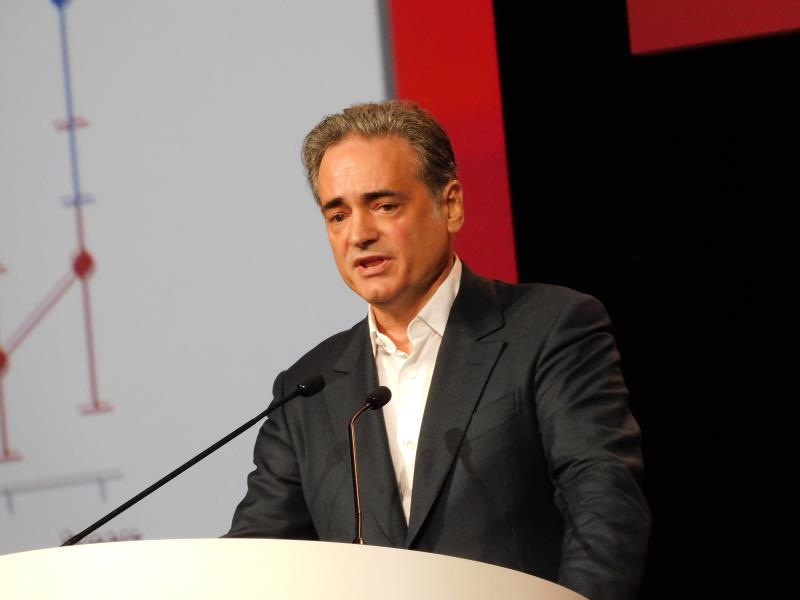 Professor Pierre Amarenco
Professor Pierre AmarencoA target low-density lipoprotein cholesterol (LDL-C) level of <70 mg/dL appeared to reduce the risk of major cardiovascular (CV) events* following an atherosclerotic ischaemic stroke, according to results of the Treat Stroke to Target trial.
A total of 2,860 patients from France and Korea who had experienced an ischaemic stroke in the past 3 months or transient ischaemic attack (TIA) in the past 15 days with evidence of atherosclerosis were given titrated doses of statin with or without ezetimibe, with the goal of achieving a target LDL-C level of 100 (±10) mg/dL (higher target; mean age 67 years, 67.3 percent male) or <70 mg/dL (lower target; mean age 66.4 years, 67.9 percent male). Most patients had experienced an ischaemic stroke (85.6 and 86.0 percent in the lower- and higher-target groups, respectively) and 56.4 and 54.2 percent, respectively, were statin-naïve at baseline.
Mean LDL-C at baseline was 135 mg/dL and patients in the higher- and lower-target groups achieved mean targets of 96 and 65 mg/dL, respectively, mostly with statin monotherapy (94 and 66 percent of patients, respectively).
At a median 3.5 years, patients in the lower-target group experienced significantly greater reduction in the incidence of major CV events (primary outcome) compared with patients in the higher-target group (8.5 percent vs 10.9 percent; adjusted hazard ratio [adjHR], 0.78, 95 percent confidence interval [CI], 0.61–0.98; p=0.036). [AHA 2019, LBS 6; N Engl J Med 2019;doi:10.1056/NEJMoa1910355]
The lower CV risk with the lower target was generally consistent across multiple CV outcomes assessed including MI and urgent coronary revascularization (HR, 0.64), cerebral infarction or TIA (HR, 0.87), vascular death (HR, 0.69), all-cause death (HR, 0.97), or requirement of any revascularization procedure (HR, 0.93), though the upper limit of the CIs all crossed 1.00.
Additionally, the relative risk reductions in the primary outcome were 33 percent in patients with MRI- or CT-proven ischaemic stroke, 40 percent in diabetic patients, and 36 percent in patients who spent >50 percent of their time in the target of <70 mg/dL, said lead author Professor Pierre Amarenco from the Bichat Hospital in Paris, France, who presented the results.
Although there was a 38 percent increased risk of intracranial haemorrhage (ICH) with the lower target, the risk of ICH plus the primary outcome was reduced by 20 percent in the lower- vs the higher-target group (9.3 percent vs 11.5 percent; HR, 0.80, 95 percent CI, 0.63–1.00). There was no significant between-group difference in incidence of newly diagnosed diabetes (HR, 1.27).
The future of MACE prevention in stroke: LDL-C <70 mg/dL?
According to Amarenco, current AHA/ASA** guidelines, based on the SPARCL*** trial in 2006, recommend intense statin therapy following an atherosclerotic ischaemic stroke. However, there is no recommended LDL-C target in the guidelines, and as such, the recommended target LDL-C level to reduce the incidence of post-stroke CV events has remained uncertain.
“This trial shows that after an ischaemic stroke with evidence of atherosclerosis, a target LDL-C of <70 mg/dL compared to 100±10 mg/dL, reduced the risk of subsequent CV events with no significant increase in ICH and no increase in newly diagnosed diabetes,” he said.
“Had we used more potent lipid-lowering drugs in this trial to get <70 mg/dL, increasing the time spent in the target to close to 100 percent with PCSK9 inhibitors or equivalent, then we may have seen a greater effect size,” he added.
This is a very important result in the field of stroke prevention and is very practical for general practitioners, cardiologists, and vascular neurologists, said Amarenco. In patients with atherosclerotic stroke, we should target an LDL-C <70 mg/dL regardless of the statin used, dosage, or addition of ezetimibe, as the target level of <70 mg/dL may avoid one recurrence among five, he said.
However, Amarenco and co-authors recommended caution when interpreting the results as the study was discontinued prematurely due to lack of funding which occurred prior to achieving the target number of events.
Furthermore, stroke is a heterogeneous condition and the implications of statin treatment in patients with silent infarcts or those with ICH need to be assessed, said discussant Professor Mitch Elkind from Columbia University College of Physicians and Surgeons, New York City, New York, US.